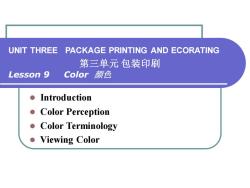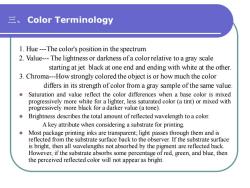陕西科技大学:《包装技术基础 Fundamentals of Packaging Technology》课程PPT教学课件(英文版)Lesson 9 Color 第9课 颜色

UNIT THREE PACKAGE PRINTING AND ECORATING 第三单元 包装印刷 Lesson 9 Color 颜色 ⚫ Introduction ⚫ Color Perception ⚫ Color Terminology ⚫ Viewing Color
UNIT THREE PACKAGE PRINTING AND ECORATING 第三单元 包装印刷 Lesson 9 Color 颜色 ⚫ Introduction ⚫ Color Perception ⚫ Color Terminology ⚫ Viewing Color

一、 Introduction ⚫ The first view of a package. recognized before shape, graphic, text content ⚫ The most important motivators of a purchase decision. ⚫ Associated with moods, feelings, places, and things. evokes observer’ s emotional response ⚫ Color has weight, size, and movement. ⚫ Color can influence perceptions such as size, quality, value, and flavor, to name a few. ⚫ Color has ethnic and social associations. ⚫ The tendency to come in and out of fashion, dominate the marketplace. ⚫ Universal rules when deciding on what colorsto make a package. ⚫ represent the persona of the package design and the perception of the targeted audience
一、 Introduction ⚫ The first view of a package. recognized before shape, graphic, text content ⚫ The most important motivators of a purchase decision. ⚫ Associated with moods, feelings, places, and things. evokes observer’ s emotional response ⚫ Color has weight, size, and movement. ⚫ Color can influence perceptions such as size, quality, value, and flavor, to name a few. ⚫ Color has ethnic and social associations. ⚫ The tendency to come in and out of fashion, dominate the marketplace. ⚫ Universal rules when deciding on what colorsto make a package. ⚫ represent the persona of the package design and the perception of the targeted audience

二 、Color Perception ⚫ The eye is a complex organ that receives light and sends stimuli to the brain for interpretation. ⚫ Color perception depends on the eye's receptors and the psychology of how the brain interpretsthe message. ⚫ The normal human eye has a retinal structure with individual receptors sensitive to red, green, and blue parts of the spectrum. ⚫ Any color in the spectrum can be matched by combining these stimuli in the proper proportions. ⚫ The human eye can differentiate several million colors. ⚫ The human eye does not detect all colors equally. Sensitivity falls off at either end of the visible spectrum. ⚫ Perceived color depends on the proportion of stimulation given each colorreceptor. color.)
二 、Color Perception ⚫ The eye is a complex organ that receives light and sends stimuli to the brain for interpretation. ⚫ Color perception depends on the eye's receptors and the psychology of how the brain interpretsthe message. ⚫ The normal human eye has a retinal structure with individual receptors sensitive to red, green, and blue parts of the spectrum. ⚫ Any color in the spectrum can be matched by combining these stimuli in the proper proportions. ⚫ The human eye can differentiate several million colors. ⚫ The human eye does not detect all colors equally. Sensitivity falls off at either end of the visible spectrum. ⚫ Perceived color depends on the proportion of stimulation given each colorreceptor. color.)

三、 Color Terminology 1. Hue -The color's position in the spectrum 2. Value- The lightness or darkness of a color relative to a gray scale starting at jet black at one end and ending with white at the other. 3. Chroma-How strongly colored the object is or how much the color differs in its strength of color from a gray sample of the same value. ⚫ Saturation and value reflect the color differences when a base color is mixed progressively more white for a lighter, less saturated color (a tint) or mixed with progressively more black for a darker value (a tone). ⚫ Brightness describes the total amount of reflected wavelength to a color. A key attribute when considering a substrate for printing. ⚫ Most package printing inks are transparent; light passes through them and is reflected from the substrate surface back to the observer. If the substrate surface is bright, then all wavelengths not absorbed by the pigment are reflected back. However, if the substrate absorbs some percentage of red, green, and blue, then the perceived reflected color will not appear as bright
三、 Color Terminology 1. Hue -The color's position in the spectrum 2. Value- The lightness or darkness of a color relative to a gray scale starting at jet black at one end and ending with white at the other. 3. Chroma-How strongly colored the object is or how much the color differs in its strength of color from a gray sample of the same value. ⚫ Saturation and value reflect the color differences when a base color is mixed progressively more white for a lighter, less saturated color (a tint) or mixed with progressively more black for a darker value (a tone). ⚫ Brightness describes the total amount of reflected wavelength to a color. A key attribute when considering a substrate for printing. ⚫ Most package printing inks are transparent; light passes through them and is reflected from the substrate surface back to the observer. If the substrate surface is bright, then all wavelengths not absorbed by the pigment are reflected back. However, if the substrate absorbs some percentage of red, green, and blue, then the perceived reflected color will not appear as bright

四、 Viewing Color ⚫ Color perception is highly subjective and depends on ·the light illuminating the object ·the nature of the object itself ·the observer of the object 1. Light Source. Light has different wavelength compositions. Standardized viewing illuminations usually at temperature 0f 5,0000 Kelvin (K). Graphic arts light composition standardized at 5,0000K Visual color comparisons should be done underthese conditions. Temperature of 5,0000Kis similar to outdoorlighting at about noon. 2. Object influences color perception directly. Surface texture, gloss, geometry, and surrounding or adjacent promote optical illusions
四、 Viewing Color ⚫ Color perception is highly subjective and depends on ·the light illuminating the object ·the nature of the object itself ·the observer of the object 1. Light Source. Light has different wavelength compositions. Standardized viewing illuminations usually at temperature 0f 5,0000 Kelvin (K). Graphic arts light composition standardized at 5,0000K Visual color comparisons should be done underthese conditions. Temperature of 5,0000Kis similar to outdoorlighting at about noon. 2. Object influences color perception directly. Surface texture, gloss, geometry, and surrounding or adjacent promote optical illusions

四、 Viewing Color 3. Observer. ⚫ Personal emotions and preferences. ⚫ Adjustments based on experience Object viewed under a fluorescent light Color-corrected by brain Photographs taken ⚫ Color perceptions altered Primary receptor suffers after image and fatigue Objective measurements with colorimeters or densitometers Numerical values to the reflected component ⚫ Instrument makes no allowance for shapes, adjacent colors, textures. Colorimetry don’t tell graphic image only verify the same as used sample. Color identified by a panel of human observers Colorimetric instrument brought in to quantify the color
四、 Viewing Color 3. Observer. ⚫ Personal emotions and preferences. ⚫ Adjustments based on experience Object viewed under a fluorescent light Color-corrected by brain Photographs taken ⚫ Color perceptions altered Primary receptor suffers after image and fatigue Objective measurements with colorimeters or densitometers Numerical values to the reflected component ⚫ Instrument makes no allowance for shapes, adjacent colors, textures. Colorimetry don’t tell graphic image only verify the same as used sample. Color identified by a panel of human observers Colorimetric instrument brought in to quantify the color
按次数下载不扣除下载券;
注册用户24小时内重复下载只扣除一次;
顺序:VIP每日次数-->可用次数-->下载券;
- 陕西科技大学:《包装技术基础 Fundamentals of Packaging Technology》课程PPT教学课件(英文版)Lesson 8 Flexible Packaging Laminates 第8课 软包装复合材料.ppt
- 陕西科技大学:《包装技术基础 Fundamentals of Packaging Technology》课程PPT教学课件(英文版)Lesson 7 Plastics in Packaging 第7课 塑料在包装中的应用.ppt
- 陕西科技大学:《包装技术基础 Fundamentals of Packaging Technology》课程PPT教学课件(英文版)Lesson 6 Glass Containers 第6课 玻璃容器.ppt
- 陕西科技大学:《包装技术基础 Fundamentals of Packaging Technology》课程PPT教学课件(英文版)Lesson 5 Metal Containers 第5课 金属容器.ppt
- 陕西科技大学:《包装技术基础 Fundamentals of Packaging Technology》课程PPT教学课件(英文版)Lesson 4 Corrugated Fiberboard Boxes 第4课 瓦楞纸板箱.ppt
- 陕西科技大学:《包装技术基础 Fundamentals of Packaging Technology》课程PPT教学课件(英文版)Lesson 3 Paper and Paperboard 第3课 纸与纸板.ppt
- 陕西科技大学:《包装技术基础 Fundamentals of Packaging Technology》课程PPT教学课件(英文版)Lesson 2 Packaging Functions 第2课 包装的功能.ppt
- 陕西科技大学:《包装技术基础 Fundamentals of Packaging Technology》课程PPT教学课件(英文版)Lesson 20 Filling Systems 第20课 充填灌装系统.ppt
- 陕西科技大学:《包装技术基础 Fundamentals of Packaging Technology》课程PPT教学课件(英文版)Lesson 1 A History of Packaging 第1课 包装发展史.ppt
- 陕西科技大学:《包装技术基础 Fundamentals of Packaging Technology》课程PPT教学课件(英文版)Lesson 19 The Packaging Line 第19课 包装线.ppt
- 陕西科技大学:《包装技术基础 Fundamentals of Packaging Technology》课程PPT教学课件(英文版)Lesson 18 General Overview 第18课 概述.ppt
- 陕西科技大学:《包装技术基础 Fundamentals of Packaging Technology》课程PPT教学课件(英文版)Lesson 17 Computer Aided Packaging System 第17课 计算辅助包装设计系统.ppt
- 陕西科技大学:《包装技术基础 Fundamentals of Packaging Technology》课程PPT教学课件(英文版)Lesson 16 Distribution Packaging 第16课 运输包装.ppt
- 陕西科技大学:《包装技术基础 Fundamentals of Packaging Technology》课程PPT教学课件(英文版)Lesson 15 Seven Steps for Cushioned Package Development 第15课 缓冲包装设计七步法.ppt
- 陕西科技大学:《包装技术基础 Fundamentals of Packaging Technology》课程PPT教学课件(英文版)Lesson 14 Test Method for Product Fragility 第14课 产品脆值试验方法.ppt
- 陕西科技大学:《包装技术基础 Fundamentals of Packaging Technology》课程PPT教学课件(英文版)Lesson 13 Mechanical Shock Theory 第13课 机械冲击理论.ppt
- 陕西科技大学:《包装技术基础 Fundamentals of Packaging Technology》课程PPT教学课件(英文版)Lesson 12 Shock, Vi ation, and Compression 第12课 冲击、振动和受压.ppt
- 陕西科技大学:《包装技术基础 Fundamentals of Packaging Technology》课程PPT教学课件(英文版)Lesson 11 Package Printing 第11课 包装印刷.ppt
- 陕西科技大学:《包装技术基础 Fundamentals of Packaging Technology》课程PPT教学课件(英文版)Lesson 10 Graphic Design in Packaging 第10课 包装中的平面设计.ppt
- 石河子大学:《工业工程基础》课程PPT教学课件(农机专业,2012)第8章 生产率.ppt
- 沈阳师范大学:《通风除尘与物料输送》课程教学课件(PPT讲稿)流体力学基础 1.1 第一节 空气在管道中流动的基本规律.ppt
- 沈阳师范大学:《通风除尘与物料输送》课程教学课件(PPT讲稿)流体力学基础 1.2 第二节 流动阻力和能量损失.ppt
- 沈阳师范大学:《通风除尘与物料输送》课程教学课件(PPT讲稿)流体力学基础 1.3 第三节 管路中的压力、速度和流量的测量.ppt
- 沈阳师范大学:《通风除尘与物料输送》课程教学课件(PPT讲稿)风机 2.1 第一节 离心式通风机的构造和工作原理.ppt
- 沈阳师范大学:《通风除尘与物料输送》课程教学课件(PPT讲稿)风机 2.2 第二节 离心式通风机的性能参数.ppt
- 沈阳师范大学:《通风除尘与物料输送》课程教学课件(PPT讲稿)风机 2.3 第三节 离心式通风机的选择.ppt
- 沈阳师范大学:《通风除尘与物料输送》课程教学课件(PPT讲稿)风机 2.4 第四节 离心式通风机的安装与使用.ppt
- 沈阳师范大学:《通风除尘与物料输送》课程教学课件(PPT讲稿)通风除尘技术 3.1 第一节 粉尘.ppt
- 沈阳师范大学:《通风除尘与物料输送》课程教学课件(PPT讲稿)通风除尘技术 3.2 第二节 含尘浓度、卫生标准和排放标准.ppt
- 沈阳师范大学:《通风除尘与物料输送》课程教学课件(PPT讲稿)通风除尘技术 3.3 第三节 粮食厂仓控制粉尘的通风除尘.ppt
- 沈阳师范大学:《通风除尘与物料输送》课程教学课件(PPT讲稿)通风除尘技术 3.4 第四节 除尘器.ppt
- 沈阳师范大学:《通风除尘与物料输送》课程教学课件(PPT讲稿)通风除尘技术 3.5 第五节 通风除尘网络的设计与计算.ppt
- 沈阳师范大学:《通风除尘与物料输送》课程教学课件(PPT讲稿)通风除尘技术 4.1 气力输送技术A.ppt
- 沈阳师范大学:《通风除尘与物料输送》课程教学课件(PPT讲稿)通风除尘技术 4.2 气力输送技术B.ppt
- 沈阳师范大学:《通风除尘与物料输送》课程教学课件(PPT讲稿)机械输送技术(主讲教师:陈革).ppt
- 《食品工厂设计与环境保护》课程教学课件(PPT讲稿)绪论.ppt
- 《食品工厂设计与环境保护》课程教学课件(PPT讲稿)第一章 基本建设程序和工厂设计的内容.ppt
- 《食品工厂设计与环境保护》课程教学课件(PPT讲稿)第二章 厂址选择和总平面设计.ppt
- 《食品工厂设计与环境保护》课程教学课件(PPT讲稿)第五章 辅助部门.ppt
- 《食品工厂设计与环境保护》课程教学课件(PPT讲稿)第六章 工厂卫生及生活设施.ppt
